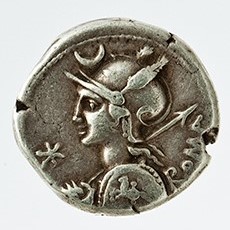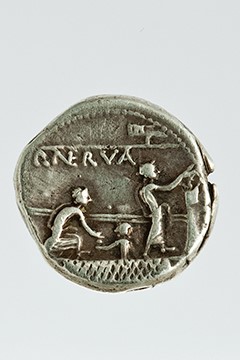Acquisition number: 1975.21
Obv.: Bust of Roma 1., wearing plumed helmet; shield on left shoulder, spear over right shoulder. Above, crescent. To left, *. To right, ROMA (upwards).
Rev.: Voting scene. On left of platform, one citizen receives ballot from attendant below. On right of platform, another citizen places ballot in box. Behind the voters, two parallel horizontal lines. Above legend, at top of coin, a line above which is a tablet bearing a letter (P?). P. NERVA.
Title: Denarius of P. Licinius Nerva - 1975.21
Acquisition number: 1975.21
Author or editor: Beryl Rawson
Culture or period: Roman Republic
Date: 113-112 BC
Material: Metal - Silver
Object type: Coins - Roman
Dimensions: 18mm (w)
Origin region or location: Italy
Origin city: Rome
Display case or on loan: 5
Keywords: Coin, denarius, Roman, Republic, Roma
Sear, D.R., Roman Coins and their Values 5 vols (London, Spink, 2000-2014) 169; Crawford, M., Roman Republican Coinage 2 vols (Cambridge, Cambridge University Press, 2011) 292/1 and pl. XL. 8; Sydenham, E. A. The Coinage of the Roman Republic (London, Spink, 1952; (Sanford J. Durst repr. 1976) 548; Seaby, H.A., Roman Silver Coins (London, B.A. Seaby, 1967) Licinia7; Grueber, H.A., Coins of the Roman Republic in the British Museum 3 vols (London, The Trustees of the British Museum, 1910; rev. edn London, 1970) II. 526.
Marshall, B., ‘Marius, Sulla, Pompeius and Caesar: the development of political advertisement on late Roman republican coins’ [online]. Teaching History 46.4 (2012), 22-28; Taylor, L.R., Roman Voting Assemblies (Ann Arbor, University of Michigan Press, 1966).
1975.21
Denarius of P. Licinius Nerva
3.953 g. 113-112 BC
Obv.: Bust of Roma 1., wearing plumed helmet; shield on left shoulder, spear over right shoulder. Above, crescent. To left, *. To right, ROMA (upwards).
Rev.: Voting scene. On left of platform, one citizen receives ballot from attendant below. On right of platform, another citizen places ballot in box. Behind the voters, two parallel horizontal lines. Above legend, at top of coin, a line above which is a tablet bearing a letter (P?). P. NERVA.
The reverse scene is the only detailed Roman voting scene known. It shows two voters on the pons (literally, ‘bridge’; i.e. gangway, plank) leading to the basket or urn where voting tablets were deposited. A number of references to these pontes show that the purpose was to separate the actual voter from the rest of the crowd in the voting enclosure. They may have existed in the time of oral (individual) voting; but their need became greater after the introduction of the secret ballot in 139 BC. In 119 BC, C. Marius (then tribune) legislated to make the gangways narrower, to give further protection against bribery, jostling and other forms of coercion.
Cicero, De Legibus 3.38, refers to the laws which provide for secrecy of the vote: that no one should ‘see the voting tablet, or question the voter, or accost him’.
In a letter to Atticus (Att. 1.14.5) written in 61 BC, during the controversy over legislation to deal with recent sacrilege of the Bona Dea (Good Goddess, a Roman fertility Goddess) ceremony, Cicero reported that on the day when a vote was to be taken on the legislation in the Popular Assembly, Clodius’ gangs took possession of the pontes to try to control who voted and how they voted. (Moreover, the voting tablets available provided only for a ‘No’ vote; the ‘Yes’ option had been omitted or erased.) Destruction of the pontes was not an uncommon way of interfering with the voting.
The usual interpretation of this scene is that the second voter is receiving his voting tablet from the attendant below. Staveley (162) points out that if this is so the vote must be on a legislative or judicial issue, where a single mark was virtually all that was necessary for the voter to make. If it were an elective Assembly, the voter would not have time on the pons to write down the names or initials of all the candidates he wished to vote for (e.g. ten for the tribuneship). But Staveley suggests (164) that the scene may represent the showing of an identity token by the voter, and that his voting tablet may already have been completed before he reached the pons.
The voters are wearing the toga: not the everyday dress of the common man in Rome, as Taylor points out (39-40), but apparently required on voting occasions.
The two parallel lines behind the voters are usually taken to indicate divisions between the voting units.
The letter on the tablet at the top of the coin may indicate which tribe is voting in this scene. (P could stand for a number of tribes, e.g. Papiria or Pomptina.)
The bust or head of Roma was the most common obverse on Roman coins in the second century BC. As often, she is here represented as a warrior goddess. Her helmet here has plumes instead of the more common wings. Roma was sometimes associated with the symbolism of Diana: the crescent here is part of that symbolism.
Sear, D.R., Roman Coins and their Values 5 vols (London, Spink, 2000-2014) 169; Crawford, M., Roman Republican Coinage 2 vols (Cambridge, Cambridge University Press, 2011) 292/1 and pl. XL. 8; Sydenham, E. A. The Coinage of the Roman Republic (London, Spink, 1952; (Sanford J. Durst repr. 1976) 548; Seaby, H.A., Roman Silver Coins (London, B.A. Seaby, 1967) Licinia7; Grueber, H.A., Coins of the Roman Republic in the British Museum 3 vols (London, The Trustees of the British Museum, 1910; rev. edn London, 1970) II. 526.
Marshall, B., ‘Marius, Sulla, Pompeius and Caesar: the development of political advertisement on late Roman republican coins’ [online]. Teaching History 46.4 (2012), 22-28; Taylor, L.R., Roman Voting Assemblies (Ann Arbor, University of Michigan Press, 1966).

